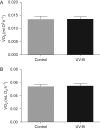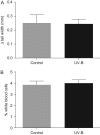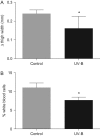Early exposure to ultraviolet-B radiation decreases immune function later in life
- PMID: 27668081
- PMCID: PMC5033135
- DOI: 10.1093/conphys/cow037
Early exposure to ultraviolet-B radiation decreases immune function later in life
Abstract
Amphibians have declined dramatically worldwide. Many of these declines are occurring in areas where no obvious anthropogenic stressors are present. It is proposed that in these areas, environmental factors such as elevated solar ultraviolet-B (UV-B) radiation could be responsible. Ultraviolet-B levels have increased in many parts of the world as a consequence of the anthropogenic destruction of the ozone layer. Amphibian tadpoles are particularly sensitive to the damaging effects of UV-B radiation, with exposure disrupting growth and fitness in many species. Given that UV-B can disrupt immune function in other animals, we tested the hypothesis that early UV-B exposure suppresses the immune responses of amphibian tadpoles and subsequent juvenile frogs. We exposed Limnodynastes peronii tadpoles to sublethal levels of UV-B radiation for 6 weeks after hatching, then examined indices of immune function in both the tadpoles and the subsequent metamorphs. There was no significant effect of UV-B on tadpole leucocyte counts or on their response to an acute antigen (phytohaemagglutinin) challenge. However, early UV-B exposure resulted in a significant reduction in both metamorph leucocyte abundance and their response to an acute phytohaemagglutinin challenge. These data demonstrate that early UV-B exposure can have carry-over effects on later life-history traits even if the applied stressor has no immediately discernible effect. These findings have important implications for our understanding of the effects of UV-B exposure on amphibian health and susceptibility to diseases such as chytridiomycosis.
Keywords: Amphibian declines; disease; immunocompetence; leucocyte; phytohaemagglutinin; ultraviolet radiation.
Figures




Similar articles
-
Exploring the link between ultraviolet B radiation and immune function in amphibians: implications for emerging infectious diseases.Conserv Physiol. 2018 Jun 28;6(1):coy035. doi: 10.1093/conphys/coy035. eCollection 2018. Conserv Physiol. 2018. PMID: 29992023 Free PMC article. Review.
-
A small increase in UV-B increases the susceptibility of tadpoles to predation.Proc Biol Sci. 2011 Sep 7;278(1718):2575-83. doi: 10.1098/rspb.2010.2368. Epub 2011 Jan 26. Proc Biol Sci. 2011. PMID: 21270039 Free PMC article.
-
Relations between conspecific density and effects of ultraviolet-b radiation on tadpole size in the striped marsh frog.Conserv Biol. 2012 Dec;26(6):1112-20. doi: 10.1111/j.1523-1739.2012.01906.x. Epub 2012 Jul 26. Conserv Biol. 2012. PMID: 22834955
-
Impacts of Exposure to Ultraviolet Radiation and an Agricultural Pollutant on Morphology and Behavior of Tadpoles (Limnodynastes tasmaniensis).Environ Toxicol Chem. 2024 Jul;43(7):1615-1626. doi: 10.1002/etc.5895. Epub 2024 Jun 5. Environ Toxicol Chem. 2024. PMID: 38837484
-
Amphibian defenses against ultraviolet-B radiation.Evol Dev. 2003 Jan-Feb;5(1):89-97. doi: 10.1046/j.1525-142x.2003.03014.x. Evol Dev. 2003. PMID: 12492415 Review.
Cited by
-
Exploring the link between ultraviolet B radiation and immune function in amphibians: implications for emerging infectious diseases.Conserv Physiol. 2018 Jun 28;6(1):coy035. doi: 10.1093/conphys/coy035. eCollection 2018. Conserv Physiol. 2018. PMID: 29992023 Free PMC article. Review.
-
Sunlight surveillance: a simplified approach for the monitoring of harmful ultraviolet radiation in freshwater ecosystems.Biol Open. 2025 Apr 15;14(4):bio061991. doi: 10.1242/bio.061991. Epub 2025 Apr 22. Biol Open. 2025. PMID: 40261219 Free PMC article.
-
Effects of ultraviolet radiation on the activity, survival, and growth of the critically endangered northern corroboree frog.Biol Open. 2025 May 15;14(5):bio061827. doi: 10.1242/bio.061827. Epub 2025 May 13. Biol Open. 2025. PMID: 40279460 Free PMC article.
-
UV exposure causes energy trade-offs leading to increased chytrid fungus susceptibility in green tree frog larvae.Conserv Physiol. 2022 Jul 3;10(1):coac038. doi: 10.1093/conphys/coac038. eCollection 2022. Conserv Physiol. 2022. PMID: 35795017 Free PMC article.
-
Critical review of the phytohemagglutinin assay for assessing amphibian immunity.Conserv Physiol. 2023 Dec 12;11(1):coad090. doi: 10.1093/conphys/coad090. eCollection 2023. Conserv Physiol. 2023. PMID: 38090122 Free PMC article.
References
-
- Alford RA, Richards SJ (1999) Global amphibian declines: a problem in applied ecology. Annu Rev Ecol Syst 30: 133–165.
-
- Alton LA, Wilson RS, Franklin CE (2010) Risk of predation enhances the lethal effects of UV-B in amphibians. Glob Change Biol 16: 538–545.
-
- Alton LA, White CR, Wilson RS, Franklin CE (2012) The energetic cost of exposure to UV radiation for tadpoles is greater when they live with predators. Funct Ecol 26: 94–103.
-
- Ankley GT, Diamond SA, Tietge JE, Holcombe GW, Jensen KM, DeFoe DL, Peterson R (2002) Assessment of the risk of solar ultraviolet radiation to amphibians. I. Dose-dependent induction of hindlimb malformations in the Northern leopard frog (Rana pipiens). Environ Sci Technol 36: 2853–2858. - PubMed
LinkOut - more resources
Full Text Sources
Other Literature Sources

